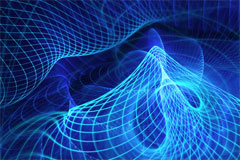 Think of a guitar string that has been tuned by stretching the string under tension across the guitar. Depending on how the string is plucked and how much tension is in the string, different musical notes will be created by the string. These musical notes could be said to be excitation modes of that guitar string under tension.
Think of a guitar string that has been tuned by stretching the string under tension across the guitar. Depending on how the string is plucked and how much tension is in the string, different musical notes will be created by the string. These musical notes could be said to be excitation modes of that guitar string under tension.
In a similar manner, in string theory, the elementary particles we observe in particle accelerators could be thought of as the “musical notes” or excitation modes of elementary strings.
In string theory, as in guitar playing, the string must be stretched under tension in order to become excited. However, the strings in string theory are floating in spacetime, they aren’t tied down to a guitar. Nonetheless, they have tension. The string tension in string theory is denoted by the quantity 1/(2 p a’), where a’ is pronounced “alpha prime”and is equal to the square of the string length scale.
If string theory is to be a theory of quantum gravity, then the average size of a string should be somewhere near the length scale of quantum gravity, called the Planck length, which is about 10-33 centimeters, or about a millionth of a billionth of a billionth of a billionth of a centimeter. Unfortunately, this means that strings are way too small to see by current or expected particle physics technology (or financing!!) and so string theorists must devise more clever methods to test the theory than just looking for little strings in particle experiments.
String theories are classified according to whether or not the strings are required to be closed loops, and whether or not the particle spectrum includes fermions. In order to include fermions in string theory, there must be a special kind of symmetry called supersymmetry, which means for every boson (particle that transmits a force) there is a corresponding fermion (particle that makes up matter). So supersymmetry relates the particles that transmit forces to the particles that make up matter.
Supersymmetric partners to to currently known particles have not been observed in particle experiments, but theorists believe this is because supersymmetric particles are too massive to be detected at current accelerators. Particle accelerators could be on the verge of finding evidence for high energy supersymmetry in the next decade. Evidence for supersymmetry at high energy would be compelling evidence that string theory was a good mathematical model for Nature at the smallest distance scales.
